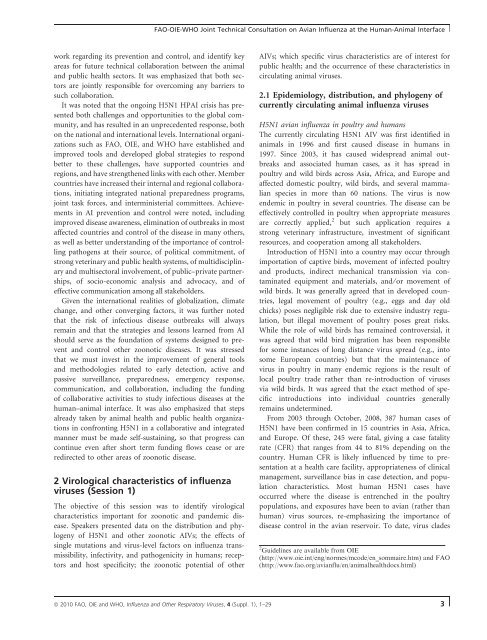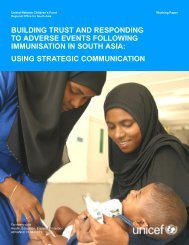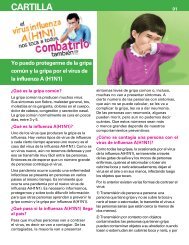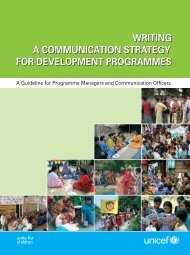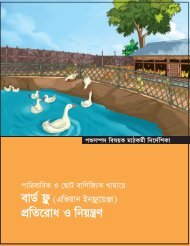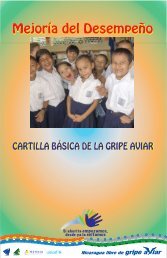FAO-OIE-WHO Joint Technical Consultation on Avian Influenza at ...
FAO-OIE-WHO Joint Technical Consultation on Avian Influenza at ...
FAO-OIE-WHO Joint Technical Consultation on Avian Influenza at ...
- No tags were found...
Create successful ePaper yourself
Turn your PDF publications into a flip-book with our unique Google optimized e-Paper software.
<str<strong>on</strong>g>FAO</str<strong>on</strong>g>-<str<strong>on</strong>g>OIE</str<strong>on</strong>g>-<str<strong>on</strong>g>WHO</str<strong>on</strong>g> <str<strong>on</strong>g>Joint</str<strong>on</strong>g> <str<strong>on</strong>g>Technical</str<strong>on</strong>g> <str<strong>on</strong>g>C<strong>on</strong>sult<strong>at</strong>i<strong>on</strong></str<strong>on</strong>g> <strong>on</strong> <strong>Avian</strong> <strong>Influenza</strong> <strong>at</strong> the Human-Animal Interfacework regarding its preventi<strong>on</strong> and c<strong>on</strong>trol, and identify keyareas for future technical collabor<strong>at</strong>i<strong>on</strong> between the animaland public health sectors. It was emphasized th<strong>at</strong> both sectorsare jointly resp<strong>on</strong>sible for overcoming any barriers tosuch collabor<strong>at</strong>i<strong>on</strong>.It was noted th<strong>at</strong> the <strong>on</strong>going H5N1 HPAI crisis has presentedboth challenges and opportunities to the global community,and has resulted in an unprecedented resp<strong>on</strong>se, both<strong>on</strong> the n<strong>at</strong>i<strong>on</strong>al and intern<strong>at</strong>i<strong>on</strong>al levels. Intern<strong>at</strong>i<strong>on</strong>al organiz<strong>at</strong>i<strong>on</strong>ssuch as <str<strong>on</strong>g>FAO</str<strong>on</strong>g>, <str<strong>on</strong>g>OIE</str<strong>on</strong>g>, and <str<strong>on</strong>g>WHO</str<strong>on</strong>g> have established andimproved tools and developed global str<strong>at</strong>egies to resp<strong>on</strong>dbetter to these challenges, have supported countries andregi<strong>on</strong>s, and have strengthened links with each other. Membercountries have increased their internal and regi<strong>on</strong>al collabor<strong>at</strong>i<strong>on</strong>s,initi<strong>at</strong>ing integr<strong>at</strong>ed n<strong>at</strong>i<strong>on</strong>al preparedness programs,joint task forces, and interministerial committees. Achievementsin AI preventi<strong>on</strong> and c<strong>on</strong>trol were noted, includingimproved disease awareness, elimin<strong>at</strong>i<strong>on</strong> of outbreaks in mostaffected countries and c<strong>on</strong>trol of the disease in many others,as well as better understanding of the importance of c<strong>on</strong>trollingp<strong>at</strong>hogens <strong>at</strong> their source, of political commitment, ofstr<strong>on</strong>g veterinary and public health systems, of multidisciplinaryand multisectoral involvement, of public–priv<strong>at</strong>e partnerships,of socio-ec<strong>on</strong>omic analysis and advocacy, and ofeffective communic<strong>at</strong>i<strong>on</strong> am<strong>on</strong>g all stakeholders.Given the intern<strong>at</strong>i<strong>on</strong>al realities of globaliz<strong>at</strong>i<strong>on</strong>, clim<strong>at</strong>echange, and other c<strong>on</strong>verging factors, it was further notedth<strong>at</strong> the risk of infectious disease outbreaks will alwaysremain and th<strong>at</strong> the str<strong>at</strong>egies and less<strong>on</strong>s learned from AIshould serve as the found<strong>at</strong>i<strong>on</strong> of systems designed to preventand c<strong>on</strong>trol other zo<strong>on</strong>otic diseases. It was stressedth<strong>at</strong> we must invest in the improvement of general toolsand methodologies rel<strong>at</strong>ed to early detecti<strong>on</strong>, active andpassive surveillance, preparedness, emergency resp<strong>on</strong>se,communic<strong>at</strong>i<strong>on</strong>, and collabor<strong>at</strong>i<strong>on</strong>, including the fundingof collabor<strong>at</strong>ive activities to study infectious diseases <strong>at</strong> thehuman–animal interface. It was also emphasized th<strong>at</strong> stepsalready taken by animal health and public health organiz<strong>at</strong>i<strong>on</strong>sin c<strong>on</strong>fr<strong>on</strong>ting H5N1 in a collabor<strong>at</strong>ive and integr<strong>at</strong>edmanner must be made self-sustaining, so th<strong>at</strong> progress canc<strong>on</strong>tinue even after short term funding flows cease or areredirected to other areas of zo<strong>on</strong>otic disease.2 Virological characteristics of influenzaviruses (Sessi<strong>on</strong> 1)The objective of this sessi<strong>on</strong> was to identify virologicalcharacteristics important for zo<strong>on</strong>otic and pandemic disease.Speakers presented d<strong>at</strong>a <strong>on</strong> the distributi<strong>on</strong> and phylogenyof H5N1 and other zo<strong>on</strong>otic AIVs; the effects ofsingle mut<strong>at</strong>i<strong>on</strong>s and virus-level factors <strong>on</strong> influenza transmissibility,infectivity, and p<strong>at</strong>hogenicity in humans; receptorsand host specificity; the zo<strong>on</strong>otic potential of otherAIVs; which specific virus characteristics are of interest forpublic health; and the occurrence of these characteristics incircul<strong>at</strong>ing animal viruses.2.1 Epidemiology, distributi<strong>on</strong>, and phylogeny ofcurrently circul<strong>at</strong>ing animal influenza virusesH5N1 avian influenza in poultry and humansThe currently circul<strong>at</strong>ing H5N1 AIV was first identified inanimals in 1996 and first caused disease in humans in1997. Since 2003, it has caused widespread animal outbreaksand associ<strong>at</strong>ed human cases, as it has spread inpoultry and wild birds across Asia, Africa, and Europe andaffected domestic poultry, wild birds, and several mammalianspecies in more than 60 n<strong>at</strong>i<strong>on</strong>s. The virus is nowendemic in poultry in several countries. The disease can beeffectively c<strong>on</strong>trolled in poultry when appropri<strong>at</strong>e measuresare correctly applied, 2 but such applic<strong>at</strong>i<strong>on</strong> requires astr<strong>on</strong>g veterinary infrastructure, investment of significantresources, and cooper<strong>at</strong>i<strong>on</strong> am<strong>on</strong>g all stakeholders.Introducti<strong>on</strong> of H5N1 into a country may occur throughimport<strong>at</strong>i<strong>on</strong> of captive birds, movement of infected poultryand products, indirect mechanical transmissi<strong>on</strong> via c<strong>on</strong>tamin<strong>at</strong>edequipment and m<strong>at</strong>erials, and ⁄ or movement ofwild birds. It was generally agreed th<strong>at</strong> in developed countries,legal movement of poultry (e.g., eggs and day oldchicks) poses negligible risk due to extensive industry regul<strong>at</strong>i<strong>on</strong>,but illegal movement of poultry poses gre<strong>at</strong> risks.While the role of wild birds has remained c<strong>on</strong>troversial, itwas agreed th<strong>at</strong> wild bird migr<strong>at</strong>i<strong>on</strong> has been resp<strong>on</strong>siblefor some instances of l<strong>on</strong>g distance virus spread (e.g., intosome European countries) but th<strong>at</strong> the maintenance ofvirus in poultry in many endemic regi<strong>on</strong>s is the result oflocal poultry trade r<strong>at</strong>her than re-introducti<strong>on</strong> of virusesvia wild birds. It was agreed th<strong>at</strong> the exact method of specificintroducti<strong>on</strong>s into individual countries generallyremains undetermined.From 2003 through October, 2008, 387 human cases ofH5N1 have been c<strong>on</strong>firmed in 15 countries in Asia, Africa,and Europe. Of these, 245 were f<strong>at</strong>al, giving a case f<strong>at</strong>alityr<strong>at</strong>e (CFR) th<strong>at</strong> ranges from 44 to 81% depending <strong>on</strong> thecountry. Human CFR is likely influenced by time to present<strong>at</strong>i<strong>on</strong><strong>at</strong> a health care facility, appropri<strong>at</strong>eness of clinicalmanagement, surveillance bias in case detecti<strong>on</strong>, and popul<strong>at</strong>i<strong>on</strong>characteristics. Most human H5N1 cases haveoccurred where the disease is entrenched in the poultrypopul<strong>at</strong>i<strong>on</strong>s, and exposures have been to avian (r<strong>at</strong>her thanhuman) virus sources, re-emphasizing the importance ofdisease c<strong>on</strong>trol in the avian reservoir. To d<strong>at</strong>e, virus clades2 Guidelines are available from <str<strong>on</strong>g>OIE</str<strong>on</strong>g>(http://www.oie.int/eng/normes/mcode/en_sommaire.htm) and <str<strong>on</strong>g>FAO</str<strong>on</strong>g>(http://www.fao.org/avianflu/en/animalhealthdocs.html)ª 2010 <str<strong>on</strong>g>FAO</str<strong>on</strong>g>, <str<strong>on</strong>g>OIE</str<strong>on</strong>g> and <str<strong>on</strong>g>WHO</str<strong>on</strong>g>, <strong>Influenza</strong> and Other Respir<strong>at</strong>ory Viruses, 4 (Suppl. 1), 1–29 3


